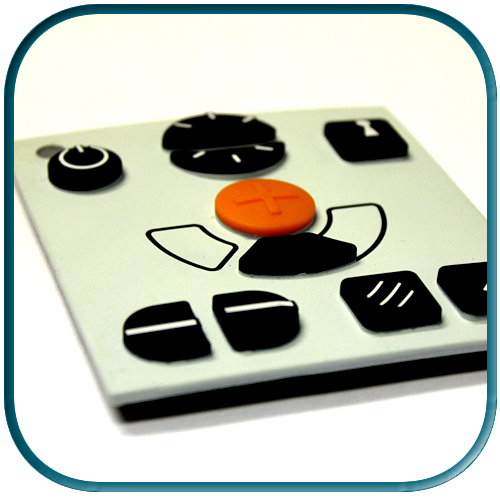RUBBER KEYPADS - WE ARE EXPERTS
ECI Technologies rubber keypads add a completely new dimension to your product, taking it from a 2D façade to the 3D world. ECI’s custom rubber keypad capabilities allow you to design the complete keypad as well as each key in any shape, size or color.
We can add them to a membrane switch with metal dome tactility, creating ECI’s “Sure Touch” feel, or build the tactility into the rubber keypad itself. Rubber keypads are ideal for backlighting as the raw silicon material makes the perfect light diffuser.
Silicon rubber keypads can be manufactured using both compression and injection molding technologies. Injection molding limits your design to non-conductive actuators (which can then be printed with conductive carbon) and one color rubber. Compression molding allows you to have multicolored keys, carbon or gold pills, or actuators for metal domes.
THERE ARE MANY OPTIONS TO CONSIDER IN CUSTOM RUBBER keypads:
Carbon or Gold Pills with Webb-Based design
When designing the tactility into the rubber, it is necessary to add a carbon or gold pill in the actuator area at the base of the switch center which makes contact with a PCB or flexible circuit. When depressing a key, the webbing will deform producing a tactile response. When pressure is removed from the switch the webbing returns to its neutral position with positive feedback. The tactile response and travel of a key can be designed to create a myriad of feels and tactile ratio’s by changing the web design and/or the hardness of the silicone material. The force to actuate a key can be as high as 500g depending on key size and shape. (Please see electronic design info below)
Metal Dome Actuators
Metal domes can be used to create the tactile response. They offer a much more uniform feel than the traditional webbing based design. Webbing based designs need the web area to be very thin which can lead to the tearing of key from the rubber base. Metal dome designs do not need the very thin areas to create the tactile feedback so they are much more robust.
Laser Etched Graphics
Laser etching is a process using laser technology to remove/etch the top color layer of a painted keypad to reveal lighter colored layers below. This process is normally used to produce an enhanced backlight effect by only lighting the legends or logo’s on a keypad to produce a wide range of effects.
Exotic Key Shapes and Colors
Virtually any key shape, size and color can be designed into your product.
Pigments can be added to the un-cured silicone prior to the molding process allowing you to design keypads with multi colored keys and graphics. Individual legends can then be printed or laser etched on each key allowing full customization of the keypad for its application.
Because the keypads are molded, they can be designed to your specification from very basic to the ultra-exotic. Tooling will be more expensive with “exotic” designs but per piece costs will not be greatly affected.
Different durometers (hardness)
Different feels, both esthetic and tactile, can be created using a different durometer of silicon. You can also have different durometers in each keypad by pre-molding key tops and then loading them into the mold prior to the final molding process.
Environmentally Sealed RUBBER KEYPADS
Environmental sealing can be created by compressing the keypad base in the assembly process. This can make rubber keypads ideal for outdoor use and in difficult environments. Care needs to be taken not to over-compress it as this can interfere with the tactile response.
Design Parameters and Suggestions
Typical chamfer dimension: 0.5 mm.
Typical chamfer angle: 45°
Typical air channel dimension: 2.0-3.0 wide x 0.3-0.5 mm deep.
Typical base thickness:1.0 mm.
Minimum distance from edge to webbing: 1.0 mm.
Typical webbing dimension: key size + 2.0 mm
Minimum pre-molded key top dimension:≥1.5 mm.
Minimum side edge radius: 0.2 mm on square or rectangular keys.
Minimum top edge radius: 0.3 mm for keys requiring a 1° taper
Minimum radius: 2.0 mm
Minimum mounting “pull thru” hole dimension: ≥ 1.0 mm.
Minimum distance from hole to webbing of switch: 1.0 mm.
Minimum webbing spacing dimension: 1.0 mm.
Minimum clearance between bezel and keys: 0.3 mm
Minimum key pitch dimension: 2.0 mm.
Typical pill size dimension (circular pills): 1.5-8.0 mm.
Minimum dimension:0.6 mm.
Minimum taper dimension: 1 taper on all keys when button height above switch membrane exceeds 10 mm.
Minimum contact size dimension: 2.0 mm smaller than minimum key top dimension for reliable switch closure.
The snap ratio of a keypad determines the tactile feel. To create acceptable tactile response, it is suggested that a designer should maintain a snap ratio of 40%-60%. If the ratio is dropped below 40% the keys will lose tactile feel.
Assuming that FI = the actuation force and F2 = the contact resistance the snap ratio for a key can be calculated by taking (F1) and (F2) then divide by (F1).Contact resistance can be customized based on a designer’s needs by using different types of pills or domes. A basic carbon pill will be around 20 to 100 ohms. A low resistance contact pill can be 10 ohms. The difference is based on carbon content.
Gold pills and gold metal domes can be used to get as low as 1 ohm.Keypads with printed or laser etched icons should be specified to have a PU coating applied. This coating will protect and enhance the life of the icons.
You can design the top of the keypad, then give us the tactile force requirements and we will design the appropriate web and base.
ECI TAKES YOUR IDEAS AND BRINGS THEM TO LIFE.
OUR EXPERIENCED TEAM UTILIZES MATERIALS AND TECHNIQUES THAT ARE BEST SUITED FOR YOUR APPLICATION AND AESTHETIC REQUIREMENTS. WE CONTINUALLY TEST NEW MATERIALS, PRODUCTS AND INKS IN A VARIETY OF APPLICATIONS TO CONSISTENTLY OFFER THE HIGHEST QUALITY OPTIONS FOR YOU.








